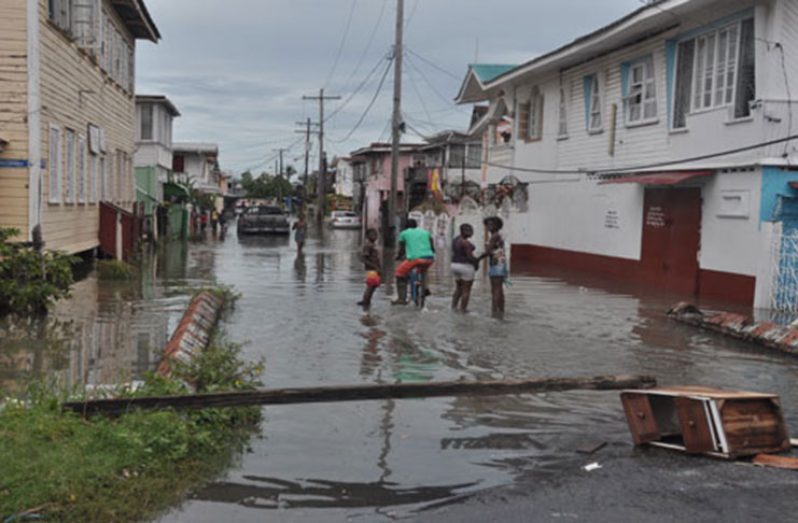When Mrs. Singh lost her only son Vishnu to malaria, after multiple misdiagnoses at the country’s health centres, it was almost reflexive to blame the underfunding of Guyana’s public universal healthcare system for his passing. While that may be true, the danger is that cases like Vishnu’s might become commonplace as climate change slowly but inexorably unleashes a wave of challenges to the country’s already struggling health sector.

A leisurely trip to the mining town of Bartica coupled with a series of unfortunate events had ended the promising life of this 22-year old.
His grieving mother explained that her son had gone with some friends on the trip and it was there he contracted malaria – a mosquito-borne disease that has plagued the hinterland regions for decades. Malaria is transmitted by the Anopheles mosquito.
“When he came back, he didn’t seem sick. But afterwards, he was showing flu-like symptoms. He lost his appetite, was having fever, vomiting and mild diarrhea.”
She said that Vishnu was taken to several doctors after these symptoms continued, but that none of them tested him for malaria. Unfortunately, the young man was misdiagnosed a few times and so without the right treatment, he died.
But Vishnu’s case of contracting a mosquito-borne disease is common in Guyana – a country which relies heavily on mining to support its economy. Neglect of mining pits after they have been exploited leads to increased breeding of mosquitoes since these pits are left with gallons upon gallons of stagnant, contaminated water.
It is for this reason that the hinterland regions, where mining is concentrated, is prone to mosquito-borne diseases which are recorded almost on a daily basis.
The World Health Organisation (WHO) estimates that up to 500 million cases of mosquito-borne diseases are recorded every year, 90 per cent of them in Africa, and up to 2.7 million deaths annually.
Earlier this year, the Pan-American Health Organisation (PAHO) in its “Health@50 in Guyana: Progress Health Report 1966-2016” revealed that between 2011 and 2015, Guyana recorded 168,240 cases of malaria, 1255 cases of dengue and nearly 100 cases of filaria.
At the launch of the report, President David Granger also stated that it is critical to note that vector-borne diseases are running “rampant” in the country. He said that vectors, which are mainly mosquitos, do not adhere to any sovereign borders and would cause devastating effects on the human populace, adding that the risks and threats are changing constantly.
CLIMATE CHANGE
And one of these new threats is climate change.
The link between climate change and mosquito-borne illnesses is twofold. The first is that it centres around how rising temperatures may expand the area in which mosquitoes can thrive. Secondly, it focuses on how changing precipitation patterns can have short and long term effects on habitats for mosquitoes.
A WHO report titled “Climate Change and vector-borne diseases: A regional analysis” states that by 2100, it is estimated that average global temperatures will have risen by 1.0 – 3.5°C, “increasing the likelihood of many vector-borne diseases in new areas.”
Between 2030 and 2050 WHO also estimates that climate change will be responsible for causing approximately 250,000 additional deaths per year; 60,000 of these from malaria. Presently, malaria kills almost 600,000 people annually.
What this therefore means is that between 2030 and 2050, in addition to the average global deaths due to malaria, climate change will be responsible for 60,000 more deaths due to the disease’s spread in new areas.
Likewise, some scientists estimate that by 2080, six billion people will be at risk of dengue (another mosquito-borne disease), compared with 3.5 billion currently, unless climate change slows. Dengue (transmitted by Aedes aegypti mosquito) is presently the world’s most popular mosquito-borne disease, with 2.5 billion people worldwide at risk of infection and 20 million cases a year in more than 100 countries.
According to WHO, Dengue has recently been reported in China, Portugal and the state of Florida in the USA.
One person who was lucky to have escaped the life-threatening effects of dengue was Sharon Phillips, a 21-year old single parent who spent three months of her young life recovering from this disease.
Sharon related that she started experiencing high fever and severe joint and muscle pain one day after she had returned home from work.

“Although it was a few years ago, I remember it like it was yesterday because the feeling was as if you are going to die; the pain, it had me crying,” she recalled.
Thinking it was just symptoms of a “normal virus” she might have contacted, the young mother used painkillers that day and retired to bed. She would ignore the excruciating joint pain and fever for the next few days, and it was not until her nose began bleeding, that she eventually rushed, scared, to one of the country’s public hospitals.
“I hadn’t money to go to a private hospital because it is very expensive and I had my daughter to take care of at the same time,” she stated.
After waiting for more than three hours for medical attention, Sharon was admitted to the hospital and a blood test was done. She was diagnosed with dengue. But the 21-year old reveals that this discovery wasn’t surprising to her.
“The area I live in has lots of bush (vegetation) and it is very low-lying, so every time rain falls, the area is flooded. This stagnant water causes a lot of mosquito to breed so the area is known to have lots of mosquitoes.”
And according to the country’s Chief Medical Officer (CMO) Dr. Shamdeo Persaud, these are conditions which this type of mosquito finds favourable.
“Storing water [due to long dry seasons] is one factor and we have seen contribute to creating a more conducive habitat for mosquitoes. The Aedes aegypti mosquito for instance likes to breed in artificial containers, and these include water tanks, plastic containers and tires among other things,” he confirmed.
This type of mosquito also transmits diseases such as Zika, yellow fever viruses, chikungunya and dengue.
Just recently there were outbreaks of both Zika and chikungunya in Guyana.
Dr. Persaud added his voice to the list of persons confirming the link between climate change and mosquito-borne diseases.
MIGRATION
He referenced the fact that over the last few years, the Anopheles mosquito was observed and it was discovered that they are being pushed further into the hinterlands, partly because of more conducive temperatures in those areas.
As such, he noted that cases have been popping up in areas where the disease was not known to have affected persons previously.
A 2013 study in the journal, Proceedings of the National Academy of Sciences (PNAS) also describes the “complex feedbacks” between climate and mosquito-borne illness as highly “location-specific.”
Further proof of this link between climatic conditions and the spread of mosquito-borne diseases was pointed out by Paul Reiter of the Dengue Branch, Division of Vector-Borne Infectious Diseases at the US Department of Health and Human Services.
In his report titled “Climate Change and Mosquito-Borne Disease,” Reiter stated that it “has been suggested that the incidence of malaria in the tropics could increase by up to 60% as a result of global warming.”
Although he did not say by what year this was likely to happen, the researcher revealed that in the highlands of southeastern Uganda, records at a well-staffed mission hospital show a 70-fold increase in malaria incidence from the late 1960s to the mid-1990s, with a signicant epidemic in 1994.
In the West Kenya Highlands, he noted too that Malaria has become a “serious public health problem” over the past 20 years. In previous decades, transmission was relatively low. Similarly, Amani hills of northeastern Tanzania were once virtually malaria-free, but prevalence has risen to very high levels in the past three decades.
In these cases, what was interesting to observe in was that the common denominator was rising temperatures in these areas. This, Reiter states, contributed to creating a more conductive environment for mosquitoes to thrive in these new areas.
Similarly, in 1999, West Nile virus, which originated in Uganda and is spread by mosquitoes, killed seven people in New York City. In 2014, chikungunya afflicted 11 Florida residents, and cases have since been reported in 46 states and Washington, D.C. In each case, the virus to blame had not previously been reported in the affected area.
WHO has also indicated that reports from Greece say that malaria has returned there for the first time in 40 years.
Despite overwhelming evidence of climate change and its devastating effects, Presidential Advisor on the Environment, Rear Admiral (Rtd.) Gary Best believes that states’ attitudes towards this issue remain, in the main, the same.
FOOTING THE TAB
He contends “…the rich [states] are called upon by the not–so-rich to reduce greenhouse gas emissions, while at the same time suspicions abound among the developing states that the rich intend to thwart their economic growth and so they resist signing protocols.”
On the international front, Guyana is regarded as a champion, leading the fight against climate change. But while incidences of irresponsible mining activities and deforestation indicate that more could be done locally, health activist Sherlina Nageer believes that the country has been “doing more of the same that we’ve been doing all the time.”
She made specific reference to mining, which she said is responsible for “destroying the environment.”
Nageer, who holds a Masters’ Degree in Public Health, believes that “we’re going to keep getting more of the same – more malaria, more dengue, more of all the vector-borne diseases.”
And while she believes that no new practice could be introduced to help with prevention, the activist said that what is needed is transition towards living more sustainably, even while traditional practices such as using a mosquito net are continued.
“What we really need to do, if we really want to prevent these illnesses, is to live more sustainably; less mining etcetera, which we aren’t ready, willing, or able to do.”
And Junior Public Health Minister Karen Cummings agrees with Nageer.
She said that it has been realised that methods such as using mosquito nets have proven to be effective in combating these diseases, and that is why the government has intensified its efforts in in these areas.
“In addition to our ongoing effort of distributing treated mosquito nets countrywide, we have taken a multi-dimensional approach to deal with mosquito-borne diseases,” the Minister said.
In 2016, the Government allocated GYD$3.2B in the national budget for disease control; these included mosquito borne diseases.
In addition to this allocation, Guyana has been a Principal Recipient of a Global Fund malaria grant. The Global Fund has invested US$42M in Guyana to date and from this 121,000 insecticide-treated nets have been distributed to residents countrywide. Malaria surveillance activities and the distribution of these nets are implemented by the Ministry of Health’s Vector Control Services (VCS) department.
However, an investigation has since revealed that employees from the Health Ministry had inflated the number of nets reported as distributed and fabricated documents to support the inflated figures.
But this will not diminish the efforts of the Ministry.
The Minister explained that the Public Health Ministry has developed an action plan to deal with the threat of mosquito-borne illnesses. The plan of action focuses on: Pushing an awareness campaign; surveillance and monitoring of these diseases; mapping affected areas and trends; strengthening the provision of health services; and training and capacity building for medical health professionals.
“We do not take lightly, the risks mosquito or vector-borne diseases pose. The lives of our citizens is of national importance and we have a responsibility to ensure that every citizen is safe and healthy; and that is what we will work tirelessly to ensure,” the Minister declares.
And should Government succeed in its efforts, by 2017 Guyana will have 80 per cent of its 740,000 population free from the risks of mosquito-borne diseases, says Dr. Horace Cox, Head of the Vector Control Services.
He too, elaborated on the steps being taken by the Health Ministry, highlighting the fact that his department will commence conducting house-to-house visitation to distribute mosquito nets to families who are without.
Meanwhile, he sought to advise persons take precautionary measures even as the Ministry continue its efforts to fight these deadly diseases.
To protect themselves against mosquito-borne diseases, persons are advised to keep their living surroundings clean, and this includes having clean drains, not having stagnant water in artificial containers, and not having garbage exposed.
They are also advised to use mosquito nets and health-approved repellants, screen their houses, and avoid being in environments where they are at risk of being stung.
It is recommended too that persons wear long light-colour garments in the evenings to reduce the risk of attracting these parasites.
If a person believes he or she may have been stung, or otherwise exposed to mosquitoes, that person should visit the nearest health center for medical treatment as soon as possible.



.jpg)











